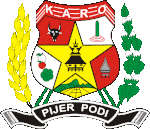Berastagi
Berastagi (Dutch: Brastagi), meaning "rice store", is a town and district of Karo Regency situated on a crossroads on the main route linking the Karo highlands of Northern Sumatra to the coastal city of Medan. Berastagi town is located around 66 kilometers (41 miles) south of Medan and about 1,300 meters (4300 feet) above sea level. The village rose to significance when Dutch settlers in Sumatra opened a boarding school there in the 1920s.
Berastagi | |
|---|---|
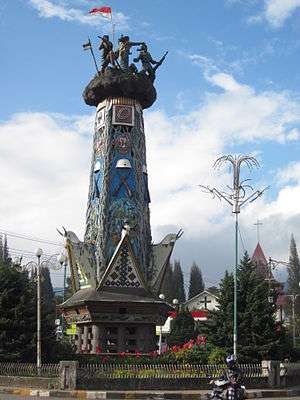 Heroic Monument, Berastagi | |
| Country | Indonesia |
| Province | North Sumatera |
| Regency | Karo Regency |
| Elevation | 1,300 m (4,773 ft) |
| Population (2011 Census) | |
| • Total | 44,765 |
| Time zone | UTC+7 (WIB) |
| Website | http://www.karokab.go.id/in/ |
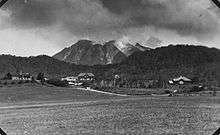
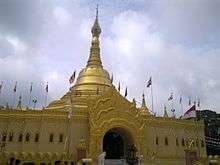
Located in the Barisan Mountains area, the mean annual temperature of the district is 18 °C (64 °F). During the day the temperature rises over 25 °C (77 °F) but at night to early morning it could drop to as low as 12 to 16 °C (53 to 61 °), it could also reach 9 °C (48 °F) during the rainy season. The weather can be fair and sunny during the day but may become foggy around dusk to night.
The main economic activities in Berastagi centers on the colorful fruit and vegetable market, as well as tourism. Berastagi is famous for its passion fruit. The main attractions of the town are the two active volcanoes; Mount Sibayak, with its hot springs, and Mount Sinabung. Each mountain can be climbed in one day, but a guide is needed.[1]
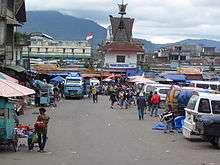
The town is also a stop on the way to Lake Toba. The dominant ethnic and linguistic group is Karo Batak.
Berastagi is 11 km from the capital Karo Regency government in Kabanjahe. Airport bus from Kabanjahe directly to the new Kuala Namu International Airport v.v. is available.
Administration
Villages
It borders Barusjahe and Tigapanah to the east, Simpang Empat, to the west, Deli Serdang Regency to the north and Kabanjahe to the south.
There are 9 villages, called desa, in Berastagi district. It is the smallest (30.5 square kilometres), and most densely populated (1530 persons/square kilometre) district of Karo Regency.[2] Elevation is 1400 metres.
Desas with population (2007):[3]
- Gurusinga, 3,900
- Raya, 4,358
- Rumah Berastagi, 6,611
- Tambak Lau Mulgap I, 2,677
- Tambak Lau Mulgap II, 3,147
- Gundaling I, 8,388
- Gundaling II, 5130
- Sempajaya, 7,115
- Doulu, 2,011
Demographics
The population of Berastagi district is 44,765, as of 2011. It is the second-most populous district in Karo Regency, after Kabanjahe.[4] Berastagi District has significantly more Muslims than most parts of Karo Regency, with 17,801 Muslims, 5,042 Catholics, 29,195 Protestants, 1,245 Hindus or Buddhists, and 54 others, Sempajaya has the highest percentage of Muslims among the desas, being 67% Muslim. There are 28 mosques, 29 churches, and 2 Buddhist temples in the subdistrict.
The town also has a diverse ethnic group as many newcomers from other area open a business around, aside the Batak Karo and Toba people, there are significant Javanese, Chinese and also Achehnese living in. 97% of primary-age children are in school, but only 77% of high-school-age children. There are 26 junior schools, 8 middle schools, and 9 high schools within the district.
Economy
Agriculture
Agriculture is much less important in Berastagi (and Kabanjahe) than the rest of Karo Regency. Crops include scallions, common beans, peas, potatoes, cauliflower, cabbage, radish, Chinese cabbage, tomatoes, carrots, and chayote. Rice is not a significant crop. Fruit grown include oranges, passionfruit, kaki and avocados. There is significantly more industry in Berastagi district than the rest of Karo Regency, aided by Berastagi's 100% paved roads.
Tourism
Due to a close distance from Medan, Berastagi has been used as a nearby hill station for relaxing place from a busy city activity, many investors developed several tourism site, hotel and also villas for attracting more visitor from Medan, these places of interest are
- Gundaling, a hill located in town center, with height of more than 80m, visitors can enjoy an overview of Berastagi from here.
- Miki Holiday Hotel and Funland, a hotel with an amusement park inside, located in Sempajaya village.
- Lumbini Natural Park is a theravada style Buddhist temple that is similar to the Shwedagon Pagoda in Myanmar, built in 2010.
- Bukit Kubu (Kubu Hill), a greeny hill area with a hotel inside suitable for picnics.
- Berastagi Fruit Market, a regionally famous traditional market selling local fruits souvenirs.
- Milk Pasteurization factory, a factory that sells local pasteurized milk. Visitors can also observe the procedure of making the product.
- Tahura, abbreviated of Taman Hutan Raya (Forest park), is a forest with various types of trees. Located near the town's entry gate.
- Kebun Madu Efi, located above 1400 masl this honey apiary provides Boutique Cabins, Camping area featuring tent rentals, flower gardens, buffet dining & a picturesque mountain and hill views.
References
- "Makanan Segar dan Pasar Ramai di Brastagi". Archived from the original on September 20, 2014. Retrieved June 2, 2014.
- "Archived copy". Archived from the original on 2011-07-21. Retrieved 2010-11-10.CS1 maint: archived copy as title (link)
- http://bappeda.sumutprov.go.id/File_Upload/Data&Informasi/11_KCDA_KARO/BERASTAGI%20DALAM%20ANGKA%202008.pdf%5B%5D
- "Archived copy". Archived from the original on 2011-03-04. Retrieved 2010-11-10.CS1 maint: archived copy as title (link)
External links
| Wikimedia Commons has media related to Berastagi. |
- Gov. Investment Agency - Tourism

